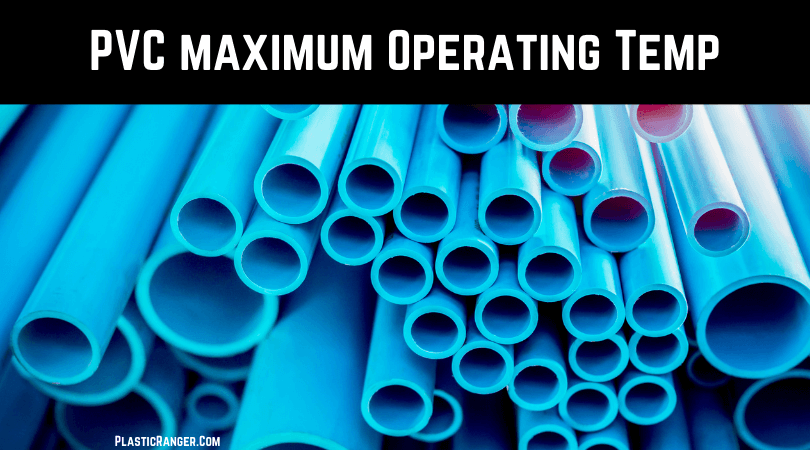Hello People, I will share an exciting insight into PVC temperature rating and how much it can withstand before deforming. Let’s get into the meat of the topic without wasting any more time.
PVC Temperature Rating

Temperature De-Rating for ASTM D 2846 CTS CPVC SDR 11 Piping Systems. For PVC and CPVC Schedule 40 & 80.
PVC Maximum Operation Temperature (°C) | Derating Factor |
| 60 | 1 |
| 65 | 0.91 |
| 70 | 0.82 |
| 75 | 0.71 |
| 80 | 0.58 |
| 85 | 0.41 |
| 90 | 0.26 |
| 95 | 0.12 |
| 100 | Not Recommended |
CPVC Temperature Rating
CPVC Maximum Operation Temperature (°C) | Derating Factor |
| 60 | 1 |
| 65 | 0.93 |
| 70 | 0.86 |
| 75 | 0.79 |
| 80 | 0.71 |
| 85 | 0.64 |
| 90 | 0.57 |
| 95 | 0.5 |
| 100 | 0.43 |
| 105 | 0.36 |
| 110 | 0.29 |
| 115 | 0.21 |
| 120 | 0.14 |
The maximum operating temperature of PVC is influenced by its molecular structure and the presence of additives.
Pure PVC has a glass transition temperature (Tg) of approximately 82°C (180°F).
Above this temperature, PVC becomes more flexible and rubbery in nature, which can affect its mechanical properties and dimensional stability.
However, it’s important to note that PVC alone is not typically used at such high temperatures in many applications due to its limitations.
Various additives and plasticizers are incorporated during manufacturing to enhance PVC’s heat resistance.
These additives help to increase the polymer’s stability and improve its properties and performance at elevated temperatures.
As a result, the maximum operating temperature of PVC can be significantly increased, making it suitable for a broader range of applications.
In general, the maximum operating temperature of PVC can range from 60°C (140°F) to 95°C (203°F) depending on the specific formulation and application requirements.
It’s crucial to consider the particular PVC grade, the presence of any reinforcing materials, and the intended use conditions when determining its maximum operating temperature.
For applications that require PVC to withstand higher temperatures, specialized formulations such as CPVC (Chlorinated Polyvinyl Chloride) are often utilized.
CPVC exhibits improved thermal stability and can handle temperatures above 95°C (203°F) up to around 93°C (200°F) for continuous use.
It’s worth noting that the maximum operating temperature is not a fixed value for PVC.
Other factors like pressure, chemical exposure, and the duration of exposure to high temperatures can also influence the material’s performance.
Therefore, consulting the manufacturer’s specifications and industry standards is crucial to ensure the PVC’s suitability for specific applications and temperature requirements.
PVC Pipe Advantages and Disadvantages
Advantages
Durability: PVC pipes are highly durable and have a long lifespan. They resist corrosion, chemicals, and impact, making them suitable for above-ground and underground applications.
Lightweight: PVC pipes are lightweight compared to other materials, such as metal or concrete pipes.
This characteristic makes them easier to handle, transport, and install, reducing labor and equipment costs.
Versatility: PVC pipes are available in various sizes and configurations, making them suitable for multiple applications.
They can be used for plumbing, drainage, irrigation, sewerage systems, electrical conduits, etc.
Excellent Flow Characteristics: PVC pipes have smooth interiors with ideal flow characteristics.
They have low friction loss, allowing efficient fluid transportation and minimizing energy consumption in pumping systems.
Cost-effective: PVC pipes are cost-effective for initial installation and long-term maintenance.
They are typically more affordable than alternative piping materials and require minimal maintenance over their lifetime.
Chemical Resistance: PVC pipes are highly resistant to chemicals, acids, alkalis, and corrosive substances commonly found in industrial and agricultural environments.
This resistance ensures the longevity and reliability of the pipes, even in harsh conditions.
Insulation Properties: PVC has excellent insulation properties, making PVC pipes suitable for applications where thermal conductivity is a concern.
They help maintain the temperature of the transported fluids, reducing heat loss or gain.
Disadvantages
Temperature Limitations: PVC pipes have temperature limitations compared to other pipe materials.
They can soften or deform at high temperatures, compromising their structural integrity.
Specialized PVC formulations like CPVC (Chlorinated Polyvinyl Chloride) are often used to address this limitation.
Limited Strength: PVC pipes have lower tensile strength than steel or ductile iron materials.
They may not be suitable for applications that require high pressure or where heavy loads or impacts are anticipated.
Vulnerability to UV Radiation: PVC pipes are susceptible to degradation when exposed to prolonged sunlight or UV radiation.
This can cause discoloration, brittleness, and reduced lifespan, especially in outdoor or above-ground installations.
UV-resistant coatings or proper insulation can help mitigate this issue.
Summary
In conclusion, understanding the maximum operating temperature and PVC temperature rating is crucial for ensuring its safe and effective use in various applications.
Additives and formulations can influence PVC’s maximum operating temperature, with CPVC often employed for higher temperature requirements.
The appropriate derating factors can be determined by referring to manufacturer specifications and industry standards, enabling the selection of the correct PVC grade for a given temperature range.
It is essential to consider factors such as pressure, duration of exposure, and chemical compatibility to maintain PVC’s integrity and optimize its performance within the defined operating temperature limits.
Thanks for reading. Have a lovely day.
Quick Navigation
